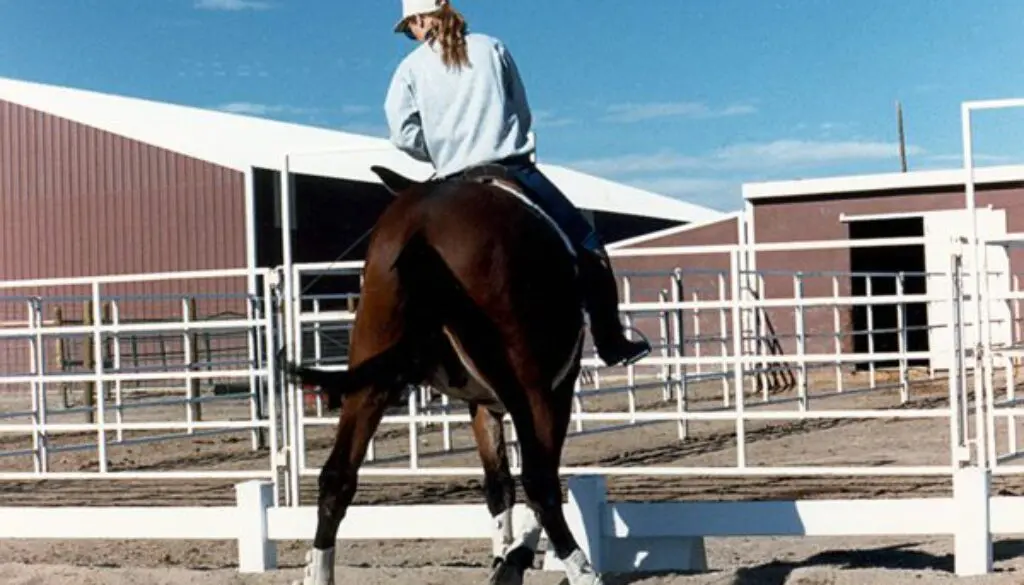MULE CROSSING: Turns On the Forehand and Haunches
By Meredith Hodges
Proper conditioning of the young equine through a carefully sequenced program of gymnastic exercises is essential to the proper development of his mind and body. Spending time cultivating a smooth, fluid forward motion, with regular rhythm and cadence, helps to develop his body properly and enables him to perform difficult movements easily.
 Work with ground rails and cavalletti helps to build muscle, particularly in the hind quarters. This will help him to carry your weight more easily through lateral movements, stops and lengthening of the gaits. Proper preparation minimizes resistance and frustration. This will be apparent in how your animal carries his tail. Is it hanging in a relaxed fashion, or is he switching his tail periodically, or regularly? You might notice that after the initial introduction of lateral moves, your equine’s forward motion has become a little “shaky” again. It is now time to clarify the connection between forward motion and lateral motion with his increased understanding of your seat and legs (Not so much the reins as your connection to the bit needs to remain quiet!). By employing a few simple exercises, this can be a very simple process.
Work with ground rails and cavalletti helps to build muscle, particularly in the hind quarters. This will help him to carry your weight more easily through lateral movements, stops and lengthening of the gaits. Proper preparation minimizes resistance and frustration. This will be apparent in how your animal carries his tail. Is it hanging in a relaxed fashion, or is he switching his tail periodically, or regularly? You might notice that after the initial introduction of lateral moves, your equine’s forward motion has become a little “shaky” again. It is now time to clarify the connection between forward motion and lateral motion with his increased understanding of your seat and legs (Not so much the reins as your connection to the bit needs to remain quiet!). By employing a few simple exercises, this can be a very simple process.
Ask your equine to walk a 20-meter circle (approximately 60 feet), while maintaining 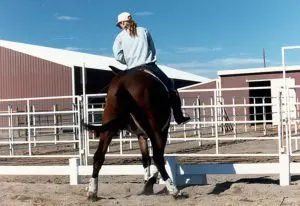 regular rhythm and cadence, proper flexion and bending through his rib cage. In rhythm, change your aids to a slight counter-bend and ask for a turn-on-the-forehand at the fence rail. Send his haunches around with pressure from your leg, well back on his barrel, until he is 180-degrees reversed. At the precise moment he is in the new position to go forward, in the opposite direction, release the pressure on your reins! Then send him forward again from your legs onto the new circle.
regular rhythm and cadence, proper flexion and bending through his rib cage. In rhythm, change your aids to a slight counter-bend and ask for a turn-on-the-forehand at the fence rail. Send his haunches around with pressure from your leg, well back on his barrel, until he is 180-degrees reversed. At the precise moment he is in the new position to go forward, in the opposite direction, release the pressure on your reins! Then send him forward again from your legs onto the new circle.
You will find that you must hold him back just a little with the reins during the turn to keep his weight on the hind quarters throughout the turn, but still maintain a forward motion. It is critical that the release comes at the instant he has completed the 180-dregree turn. While executing the turn-on-the-forehand, do not hold back on the reins with steady pressure. Use a squeeze-release action with your hands.
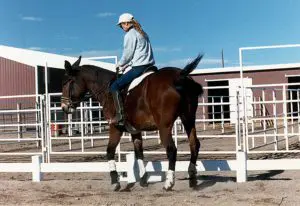 Complete the turn with a series of half-halts from your seat and a squeeze-release action with the reins. If you do this, your final release will come as a natural sequence to the turn and it will be executed in the rhythm and harmony of your equine’s movement. You can do this exercise at the walk, trot and canter, but be sure to slow down to a walk from the faster gaits in their natural sequence…canter, trot, walk and turn…trot, walk and turn. Do not be abrupt and skip the interim gaits.
Complete the turn with a series of half-halts from your seat and a squeeze-release action with the reins. If you do this, your final release will come as a natural sequence to the turn and it will be executed in the rhythm and harmony of your equine’s movement. You can do this exercise at the walk, trot and canter, but be sure to slow down to a walk from the faster gaits in their natural sequence…canter, trot, walk and turn…trot, walk and turn. Do not be abrupt and skip the interim gaits.
Next your will begin to cultivate the turn-on-the-haunches. Your equine’s lateral work on the T-poles will have given him prior understanding of this movement. Again, walk him on a 20-meter circle. When you are ready to make the turn, stop along the fence, nudge him rhythmically and firmly with your outside leg. Hold him steady with your reins and keep your weight over his center of gravity in the middle of his barrel. Keep your inside leg passive and connected, but gently quiet.
Maintain contact with your outside rein so his head remains straight, and lead him into the new direction of the turn with a squeeze-release action on your inside rein. Back it up with a rhythmic squeeze-release action coming from your leg on the opposite side. 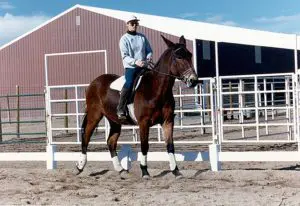 Be careful not to inhibit his forward motion. It is better that he does small circles to complete the turn at first than to fall back over his haunches and pivot on one hind foot. As in the turn-on-the-forehand, nudge his barrel on the opposite side, pushing his haunches into the turn with the squeeze-release action. Longears will tend to lean into a continuous pressure from your legs! Keep practicing this exercise, maintaining his body between your aids.
Be careful not to inhibit his forward motion. It is better that he does small circles to complete the turn at first than to fall back over his haunches and pivot on one hind foot. As in the turn-on-the-forehand, nudge his barrel on the opposite side, pushing his haunches into the turn with the squeeze-release action. Longears will tend to lean into a continuous pressure from your legs! Keep practicing this exercise, maintaining his body between your aids.
When he does well at the walk, you can move on to executing the move from the trot, and later the canter. Always slow down to the walk for the turn and go through all the gaits! Even if your equine makes a mistake, remember to praise him for his efforts and just keep going forward. If you do this, you will find him to be a much more willing partner and eventually, you will succeed with your goals.
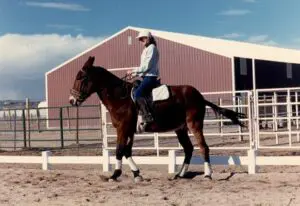 Once your equine gets his footwork figured out through these complicated movements, and has the opportunity to develop his body properly, you can begin to as for more speed and finesse on the turns, but this comes MUCH later! To attempt any more right now will most likely destroy his forward motion, cadence and rhythm. This will cause frustration and fatigue.
Once your equine gets his footwork figured out through these complicated movements, and has the opportunity to develop his body properly, you can begin to as for more speed and finesse on the turns, but this comes MUCH later! To attempt any more right now will most likely destroy his forward motion, cadence and rhythm. This will cause frustration and fatigue.
Working your mule along the fence line, will help him to keep his pivot foot planted throughout the turn and still stay balanced through his body. Abrupt turns cannot accomplish this with the finesse that he will need for optimum performance. This is an excellent exercise for improving the quality of the turn-on-the-haunches for Reining and cow work, but because of the sensitive nature of the animal and slow maturation, it can become too stressful and frustrating for a younger animal if attempted too early. The equine might even perform well for a couple of years after quicker training, but before long, he will sour on the movements. He will anticipate the moves in order to avoid soreness, and even begin to bolt. It’s better to take it slowly so it is easy for him. This will maintain your rapport and understanding in the relationship. Equines that are brought along slowly tend to live a lot longer and do not have serious issues with arthritis and other such problems. So, why get impatient and try to do too much too 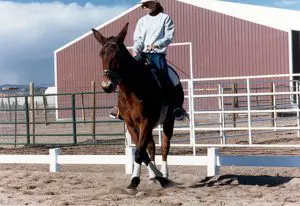 soon? Wouldn’t you rather have a long-lasting and pleasant relationship with a companion that is happy with his work?
soon? Wouldn’t you rather have a long-lasting and pleasant relationship with a companion that is happy with his work?
Your equine does not need his crimped oats reward as often as he did in before his under-saddle training. Just be sure to be generous with your rewards BEFORE you ride and then again AFTER you ride, so he fully understands that he has done well. This will ensure that his good behaviors will be consistently repeated. When you lavishly praise your equine’s successes, stroke him gently and calmly when he makes mistakes, you will only solidify the bond between you!
To learn more about Meredith Hodges and her comprehensive all-breed equine training program, visit LuckyThreeRanch.com or call 1-800-816-7566. Check out her children’s website at JasperTheMule.com. Also, find Meredith on Facebook, YouTube, Pinterest, Instagram, MeWe and Twitter.
Covered in TRAINING MULES & DONKEY: A LOGICAL APPROACH TO TRAINING, TRAINING WITHOUT RESISTANCE, EQUUS REVISITED and A GUIDE TO RAISING & SHOWING MULES at www.luckythreeranchstore.com
© 1989, 1992, 2015, 2016, 2017, 2024 Lucky Three Ranch, Inc. All Rights Reserved.

